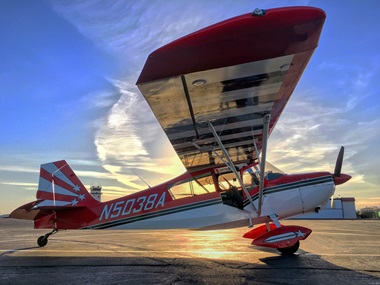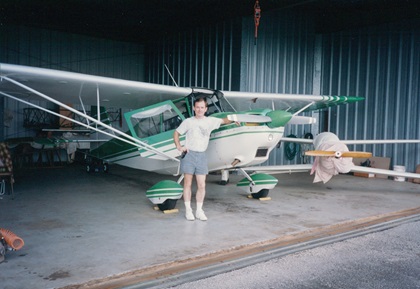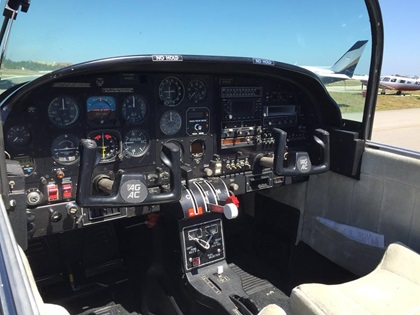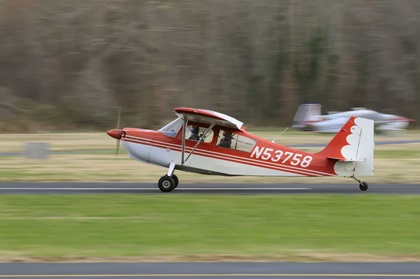The Aircraft Spotlight feature looks at an airplane type and evaluates it across six areas of particular interest to flying clubs and their members: Operating Cost, Maintenance, Insurability, Training, Cross-Country, and Fun Factor. This month we will compare the two aircraft the Flying Educators have operated in their 57-year history – the Citabria and the Grumman Tiger.
The Flying Educators is an equity club founded in 1962 based at Ft. Lauderdale Executive Airport (KFXE). For more than 30 years, the 10-member club owned a Citabria. But in the mid-90s, they decided to make a change [see this month’s Club Spotlight]. The club wanted an airplane better suited for cross-country travel and they settled on the Grumman AA5B Tiger. Former Flying Educators Club Secretary and Treasurer Greg Utley shares his thoughts on both aircraft.
Why would you want a Citabria?
“Our 115-hp Citabria was a fun, inexpensive aircraft that provided very stable air and ground handling for lower time pilots and entry-level aerobatic capabilities for more experienced pilots,” Greg said. “Even with limited power (compared to 150 and 180 hp versions), and the absence of inverted fuel and oil, there were very few maneuvers appropriate for beginning aerobatic students that the airplane couldn’t handle.”

The Citabria is a derivative of the Aeronca Champ and was first produced in 1964 by Champion Aircraft Corporation. Through various ownership changes, such as Bellanca and now American Champion Aircraft Corporation, the simple, well-liked design has continued on with additional variations being produced such as the Decathlon and Scout. Among the differences are engine size, with variations from 115 hp to 180 hp, and whether the wing spar is metal or wood.
Early models through the 1970s can be purchased starting around $35,000 with prices increasing to about $95,000 for a newer model produced after 2000.
Why would you want a Tiger?
“It was largely a matter of economics,” Greg said. The most popular of the Grumman series, the Tiger seats four, has a 180-hp engine, and burns 10 gph. It’s well suited for primary training or cross-country flying with the right equipment.
Grumman produced the AA5B Tiger from 1975 through 1979, and then American General produced the AG5B Tiger from 1991 through 1993. Similar four-seat Grummans include the 150-hp AA5 Traveler and AA5A Cheetah, and the 160-hp GA7 Cougar.
Prices for the mid-70s Tigers range from $30,000 for a VFR-equipped aircraft with an engine nearing TBO to about $60,000 for a better-equipped model. The later versions produced in the 1990s and 2000s will cost a bit more with prices in the $75,000 to $100,000 range.
Operating Costs
Citabria
According to Greg, the 115-hp Citabria burned about 5 to 6 gph, making it economical to operate. In the early ‘90’s up to the when the Flying Educators sold the Citabria in 1995, the hourly rate was $21 wet, and the monthly club dues were $42.
To provide a more up-to-date cost perspective, the Wild River Flying Club in Osceola, WI operates a 1979 Citabria with a 150-hp Lycoming O-320. It burns 7 gph and the club charges $86 an hour.
Tiger
“With a Tiger, the term ‘Bang for the Buck’ comes to mind because it’s an airplane that can probably get the most speed for the least cost,” Greg said. “And that was the main consideration.”
The specs list the cruise speed at 139 knots, but Greg said the Flying Educators usually fly at economy cruise and get 115 kts to 120 kts ground speed while the 180-hp Lycoming O360 burns 10 gph. They charge $90 an hour wet.
Aero on Demand, a Houston-based club, also operates a Tiger and it is equipped with an engine monitor providing very accurate data. “Between 4,000 feet and 10,000 feet, depending on temperature, it gets between 8.3 gph to 9.2 gph, and you’re doing 135 knots easy,” says Aero on Demand founder Michael Bletsch. With a power setting of 2550 rpm to 2600 rpm, Mike usually cruises between 135 and 138 knots.
Maintenance

“Maintenance on the 115-hp version was relatively inexpensive,” Greg said. “Major overhauls were cheap. It was a very inexpensive airplane. That was its strong suit.”
The Flying Educators did routine maintenance and annuals in-house with little difficulty, Greg said. One consideration is that long-term you have to plan for fabric recovery and fabric repair. Depending on how much exposure it has to the sun, it will need to be replaced generally about every 25 to 30 years. Since it is a tube and fabric airplane, it’s best to keep it in a hangar.
“Our Citabria wasn’t re-covered during the time Flying Educators owned it,” Greg said. “It continued to look good until it was sold. The plane was always in a hangar … probably a major factor.”
Finding a good mechanic that has tube and fabric experience and expertise is important, and it could be a little more challenging to find than someone used to working on 172s or Cherokees.
The Citabria breed has an AD requiring a one-time inspection of the wooden spar where they have to check it for cracks. There’s also a lot of wood in the Citabria, like under the seats, that needs to be inspected, and there can be rusty tubes in the tail.
Tiger
“It’s a fixed gear, fixed-pitch prop so there’s just not a whole lot that can go wrong with the airplane,” Greg noted. “We haven’t had any major problems with the Tiger.” Aero on Demand said annuals without squawks run about $1,200 depending on the going rate in your part of the country.
Although the airplane hasn’t been manufactured for quite some time, Greg said parts are easy to get. “The main parts supplier for Grumman aircraft is an outfit called Fletch Air, and I think they’re based in Houston,” he said. “They can provide anything for the airplane—wheels, wheel pants, windshields, cowlings, anything you need for a Tiger or similar Grumman aircraft—they can provide.”
Insurability
Citabria
Greg said the club didn’t have any problem renewing its insurance with Avemco. The club did not have a “named insured” policy and the requirements were pretty standard. Members only needed a current medical, current flight review, CFI checkout with logbook entry for the club aircraft make and model, and at least 10 hours in tailwheel aircraft.
“Insurance for our 1979 Citabria (Model 7-ECA) was $870 in ’89 and had risen to $2,195 when we sold it in ’95,” Greg said. “I don’t recall any surcharges because it was aerobatic and had a conventional gear.”
Tiger
Greg pointed out the first Tiger policy premium was $2,360 in 1996, which was slightly higher than the Citabria. Insurance premiums went from over $3,000 in 2002 to over $6,000 in 2010.
Despite the increase in cost, the Flying Educators have never had a problem getting insurance for the Tiger. The club uses Avemco and pays $6,000 a year, but Greg noted that Florida is an expensive state in which to insure an aircraft because of hurricanes and the fact the state is highly litigious. The hull is insured at $65,000 with $1 million liability. They have an unnamed policy, meaning they don’t have to list their members or their flight time, so anyone who joins the club is insured. Greg noted that on a named policy you’ll pay a premium based on your least experienced pilot.
Training
Citabria
In the year or two Greg was in the club while it operated the Citabria, there were no new members without prior tailwheel experience. That said, the Citabria is a good aircraft to use for tailwheel training. You solo it from the front so you’ve got good visibility, and, like the Champ it is derived from, it is an easy, forgiving airplane.
It could also be used for simple aerobatic training – things like aileron rolls, loops, spins, and upset recovery. One of the challenges is finding instructors who can teach in it – whether it’s tailwheel or aerobatic. And, if you are doing aerobatics, you need parachutes that need to be repacked regularly, which would add a cost.
 Tiger
Tiger
The Flying Educators requires members to already have their Private Pilot Certificate, but Greg would recommend the aircraft as a primary trainer. With a fixed-pitch prop and fixed gear, it’s simple to operate. However, “you have to mind your Ps & Qs,” Greg noted, “because it’s going to respond faster to control inputs than a typical trainer.”
It also has a free-castering nose wheel so steering is accomplished through differential braking, which takes a little more skill than a traditional aircraft with nose wheel steering. “The first time someone gets into an airplane like that and you’re taxiing with a crosswind, you want to drag the brake to keep it going straight,” Greg said. “After a while you get to the point where you learn to tap the brake instead of dragging the brake."
Cross-Country
Citabria
“Surprisingly, the Citabria was used for cross-country trips more often than you would think, but only if arrival time requirements weren’t challenging,” Greg said. “Considering pre-flight, trip time, rides to and from airports, etc., it was faster driving on any trip less than about 200 miles. However, the fun-factor overrode practicality from time to time.”
The plane cruised at around 115 mph and had about a 20-gallon fuel tank, Greg recalled. It’s only got two seats and a relatively small baggage compartment, so it would be similar to taking a 152 on a cross-country trip – probably not your first choice, but certainly capable for one or two people with no bags.
Tiger
The reason Flying Educators switched from owning only Citabrias for 30 years to the Tiger is so members could do more cross-country flying. “You’re going to get more airspeed out of a Tiger than you’re going to get out of most four-place aircraft in that category,” Greg said. “And a little more economically.”
Mike from Aero on Demand added, “Besides the RV, it’s the fastest 180-hp airplane out there with a fixed-pitch prop. It will keep up with an Arrow. It will keep up with a 182. They’re fast little airplanes.”
Being based in Florida, the Flying Educators have many destinations within a 500-mile radius, including the Bahamas, and members wanted an aircraft more suited to that mission.
It holds 52 gallons and has a range of about 700 miles. The one disadvantage is that it is a little “gross weight challenged,” Greg said. With full fuel, the payload is about 500 pounds or so – plenty if it’s two people flying with luggage. If you have four people, filling up to the tabs provides 38 gallons of fuel, and you should be fine for most cross-country flights.
The Flying Educator’s Tiger has a two-axis autopilot so it frequently flies under IFR. If you had a Tiger without the autopilot, it’s not going to be quite as stable as a 172 or a 182. “If you have an autopilot, it’s a wonderful cross-country bird,” Greg said.

Fun Factor
Citabria
The Citabria wins this category over the Tiger without question. It’s hard to beat a tandem seat aerobatic aircraft when it comes to fun. "Three or four of the 10 members would use it for aerobatics a lot.” Greg said.
Even if you don’t use the Citabria for aerobatics, there is something romantic about flying a taildragger with a stick – particularly one that is light and responsive to control inputs. Sitting in tandem provides an excellent view, and you’re probably more likely to land on grass and go places you might not in a Cherokee or 172, which just adds to the experience.
Tiger
For a club with a 30-year history flying only Citabrias, the members were used to something light and agile on the controls. Moving to the Grumman Tiger meant they could have a four-place aircraft better suited for cross-country travel and still have a plane that was responsive. It’s roll rate is faster than a Piper or Cessna.
“Everybody was used to flying Citabrias, which as you know is fully aerobatic,” Greg said. “The Tiger is halfway between a sport plane and a Cessna 172. It’s very responsive. If you fly a Tiger for 20 or 30 hours and get into a Cessna 172, it feels like a truck.”
The Tiger has pushrods instead of cables making the controls very responsive. “It’s super tight on the controls. If you touch it, it’s going to move an aileron or elevator,” Mike said. “You can literally fly with your pinkies.”
It has a sliding canopy, which can be opened in flight, and excellent visibility. The bonded aluminum construction eliminates the need for rivets, so even sitting on the ground it looks sleek.

Overall
You can’t go wrong with either a Citabria or a Grumman Tiger in your club. Both are inexpensive to operate and maintain, and a lot of fun to fly. It all comes down to what your mission is.
If your club wants to offer something different yet cost effective, a Citabria can help attract members who want to earn a tailwheel endorsement or do some aerobatic flying. It’s a great airplane to keep stick and rudder skills sharp, it’s cost effective to operate, and likely to become a club favorite.
If your club is looking for an economical aircraft that can serve as a primary trainer and a solid cross-country platform with good performance, the Grumman Tiger is a plane you may want to consider. It’s nimble in the air, seats four, and has a good cruising speed with minimal fuel burn. At the end of the day, Greg noted that most members fly solo or with only one passenger and, for that reason, the airplane has to be fun to fly, and it is.